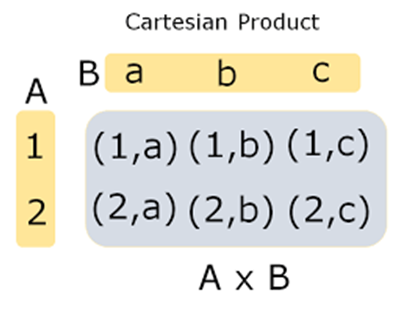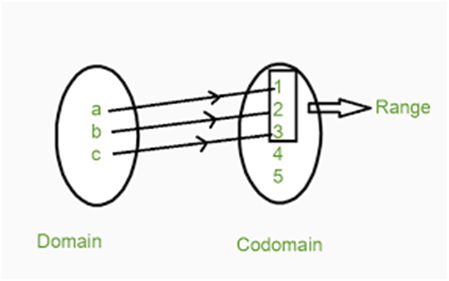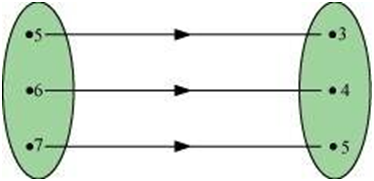- Books Name
- Mathmatics Book Based on NCERT
- Publication
- KRISHNA PUBLICATIONS
- Course
- CBSE Class 12
- Subject
- Mathmatics
Chapter-1
Relations and Functions
Cartesian Product , Relations and Types of Relations
Cartesian Product
Suppose there are two non-empty sets A and B.
Then the Cartesian product of A and B is the set of all ordered pairs of elements from A and B.
i.e., A × B = {(a , b) : a ∊ A, b ∊ B}
Example: Let A = {a1,a2,a3,a4} and B = {b1,b2}
Then, The Cartesian product of A and B will be;
A × B = {(a1,b1), (a2,b1),( a3,b1),( a4,b1).( a1,b2),( a2,b2),( a3,b2),( a4,b2 )}
Example: Let us say, A = {1,2} and B = { a,b,c}

Therefore, A × B = {(1,a),(1,b),(1,c),(2,a),(2,b),(2,c)}.
This set has 8 ordered pairs. We can also represent it as in a tabular form.
Note: Two ordered pair X and Y are equal, if and only if the corresponding first elements and second elements are equal.
Example: Suppose, A = {cow, horse} B = {egg, juice}
then, A×B = {(cow, egg), (horse, juice), (cow, juice), (horse, egg)}
If either of the two sets is a null set, i.e., either A = Φ or B = Φ, then, A × B = Φ i.e., A × B will also be a null set
Number of Ordered Pairs
For two non-empty sets, A and B. If the number of elements of A is p
i.e., n(A) = p & that of B is q
i.e., n(B) = q,
then the number of ordered pairs in Cartesian product will be n(A × B) = n(A) × n(B) = pq.
Properties
- The Cartesian Product is non-commutative: A × B ≠ B × A.
- The cardinality of the Cartesian Product is defined as the number of elements in A × B and is equal to the product of cardinality of both sets:
|A × B| = |A| * |B|
- A × B = ∅, if either A = ∅ or B = ∅
- If (x,y) = (a,b) ,then x=a , y=b
- A×B=B×A, if only A=B
- The Cartesian product is associative:
(A×B)×C=A×(B×C). It means the Cartesian product of the three-set is the same, i.e., it doesn’t depend upon which bracket is multiplied first as the final result will be the same.
- Distributive property over a set intersection:
A×(B∩C)=(A×B)∩(A×C)
- Distributive property over set union:
A×(B∪C)=(A×B)∪(A×C)
- If A⊆B, then A×C⊆B×C for any set C.
- AxBxC = {(a,b,c) : aÎA, bÎ B ,cÎ C}
Here (a,b,c) is called ordered triplet.
Relation
Relation is association between two well-defined objects.
Relation in real life give us the link between any two objects or entities. In our daily life, we come across many patterns and links that characterize relations such as a relation of a father and a son, brother and sister, etc.
Relations can be represented in different forms such as arrow representation, algebraic form, set-builder form, graphically, roster form, and tabular form.
Definition
Let A and B be two non empty sets.
Then R : A ® B is said to be a relation if R Í AxB .
The element of A (first element) of AxB in the relation is called Domain or Pre-image of relation R.
The element of B (second element) of AxB in the relation is called Range or image of relation R.
The whole B set of AxB in the relation is called Codomain of relation R.
Range Í Co-domain

Example : Define a relation R from A to A = {1, 2, 3, 4, 5, 6} as R = {(x, y) : y = x + 1}. Determine the domain, codomain and range of R.
Answer: We can see that A = {1, 2, 3, 4, 5, 6} is the domain and codomain of R.
To determine the range, we determine the values of y for each value of x, that is, when x = 1, 2, 3, 4, 5, 6
-
- x = 1, y = 1 + 1 = 2;
- x = 2, y = 2 + 1 = 3;
- x = 3, y = 3 + 1 = 4;
- x = 4, y = 4 + 1 = 5;
- x = 5, y = 5 + 1 = 6;
- x = 6, y = 6 + 1 = 7.
Since 7 does not belong to A and the relation R is defined on A, hence, x = 6 has no image in A.
Therefore range of R = {2, 3, 4, 5, 6}
Answer: Domain = Codomain = {1, 2, 3, 4, 5, 6}, Range = {2, 3, 4, 5, 6}
Example :
Let A = {1, 2, 3, … , 14}. Define a relation R from A to A by R = {(x, y): 3x – y = 0, where x, y ∈ A}. Write down its domain, codomain and range.
ANSWER:
The relation R from A to A is given as
R = {(x, y): 3x – y = 0, where x, y ∈ A}
i.e., R = {(x, y): 3x = y, where x, y ∈ A}
∴R = {(1, 3), (2, 6), (3, 9), (4, 12)}
The domain of R is the set of all first elements of the ordered pairs in the relation.
∴Domain of R = {1, 2, 3, 4}
The whole set A is the codomainof the relation R.
∴Codomain of R = A = {1, 2, 3, …, 14}
The range of R is the set of all second elements of the ordered pairs in the relation.
∴Range of R = {3, 6, 9, 12}
Example :
The given figure shows a relationship between the sets P and Q. write this relation
(i) in set-builder form (ii) in roster form.
What is its domain and range?

ANSWER:
According to the given figure, P = {5, 6, 7}, Q = {3, 4, 5}
(i) R = {(x, y): y = x – 2; x ∈ P} or R = {(x, y): y = x – 2 for x = 5, 6, 7}
(ii) R = {(5, 3), (6, 4), (7, 5)}
Domain of R = {5, 6, 7}
Range of R = {3, 4, 5}
Example:
Let R be the relation on Z defined by R = {(a, b): a, b ∈ Z, a – b is an integer}. Find the domain and range of R.
ANSWER:
R = {(a, b): a, b ∈ Z, a – b is an integer}
It is known that the difference between any two integers is always an integer.
∴Domain of R = Z
Range of R = Z

 Chintu
Chintu
